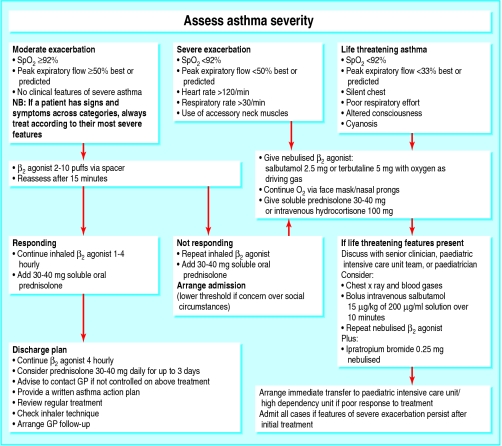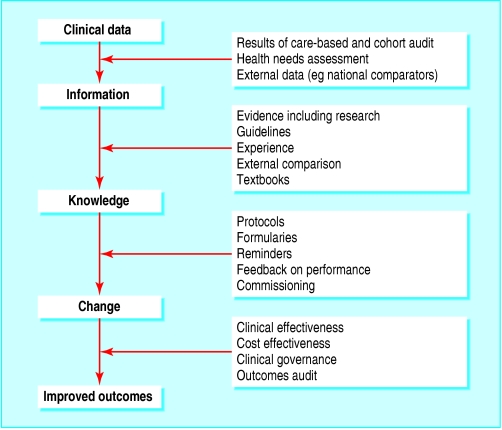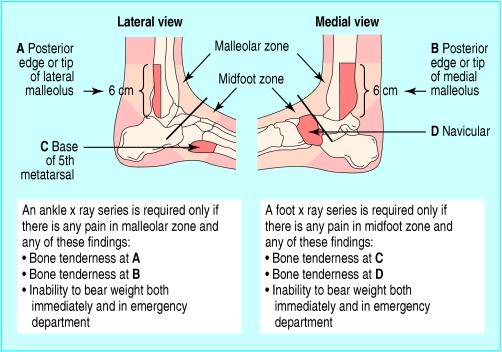Efficient consultations deal with patients' problems promptly and effectively while taking into account other relevant circumstances. Sometimes the relevant circumstance is another health problem in the patient or their family, or it could be an issue affecting society at large, such as resource constraints. The immediate role of the team caring for Patrick Murphy (see box opposite) is to deal with his severe asthma.
To do so the team needs information on the current problem, which is quickly obtained from Patrick's mother (who accompanied him in the ambulance) and background details from her or from his medical records. They also need to assess Patrick's physical status using clinical examination and other diagnostic methods. The information obtained enables the clinicians caring for Patrick to take the most effective management steps. In the longer term, data from the consultation may be used to redesign the service locally, or at the level of the health system. This article shows how informatics tools can make it easier to record important data, and that this processing can produce useful information for a low cost.
Figure 1.
Acute asthma management flow chart for children >5 years in accident and emergency department. Adapted from Scottish Intercollegiate Guidelines Network, guideline 63 (www.sign.ac.uk/guidelines/fulltext/63/index.html)
Most doctors focus on assessing the patient and carrying out immediate management steps. Some clinicians see the recording of what happened and why as a necessary evil to be done in the minimum time, with the least effort. Legal responsibilities ensure that most encounters are recorded, but the quality of data is often constrained, partly because so much data are required.
Figure 2.
Turning clinical data into improved patient outcomes
Write once, read many
Other tasks in the emergency consultation include gathering and recording information that may be useful to Patrick or other patients in the future. Paper or electronic records, or other information tools, may make it easier to record items of data that can be aggregated and analysed after the event. The data can improve efficiency when they are entered into clinical records and made available to other members of the clinical team. Wireless networks allow data to be transmitted to and from handheld computers, laptops, or desktop computers. This enables data to be shared early. An improved standard of record keeping probably means better data in the electronic patient record, which increases knowledge about the range of problems seen in clinical practice. This new knowledge informs decisions made at several levels, and contributes to better outcomes for patients.
Table 1.
Data to be recorded for acute medical admissions
| • Patient's registered general practice details |
| • Admission details (administrative) |
| • Reason for clinical encounter |
| • Presenting problem |
| • History of presenting problem |
| • Current diagnoses, problems |
| • Drugs, allergies, and diets |
| • Past illnesses, procedures, and investigations |
| • Social circumstances |
| • Functional state |
| • Family history |
| • Systems review |
| • Examination results |
| • Results of investigations |
| • Overall assessment and problem list |
| • Management plan |
| • Intended outcomes |
| • Information given to patient and carers |
This is the seventh in a series of 12 articles A glossary of terms is available at http://bmj.com/cgi/content/full/331/7516/566/DC1
Patrick Murphy is a 5 year old boy who has been brought to the accident and emergency department with status asthmaticus. He is cyanosed with a poor respiratory effort
Structured recording of data
Although modern computers have massive processing and storage capacity, data needs to be recorded in code to be “understood” by computers. The computer processes and analyses the data to add meaning. Free text notes are too difficult for computers to process so that clinicians and policymakers can carry out analyses on them.
Table 2.
Classification, coding, and nomenclature
| • Classification is a method for systematically grouping something—for example, diseases. In most classifications, classes are designated by codes, which allow aspects of the things to be captured (a systematic arrangement of similar entities on the basis of certain characteristics) |
| • A code is usually a unique numeric or alphabetic representation of items in a classification |
| • Nomenclature is a system of naming used in a branch of knowledge. Medical nomenclature attempts to standardise the names used for patient findings, diseases, interventions, and outcomes |
Although there are many coding and classification systems, according to Gardner, one system aims to “create a new world standard for computerising medical terminology.” It is called the systematised nomenclature of medicine and clinical terms (SNOMED-CT) system. This coding system will be used in the NHS. It is a detailed, coded classification of medical terms and concepts, and has more than 150 000 terms and codes that are organised into 11 linked, hierarchical modules. Doctors will not see, and do not have to remember, all these codes. They use the interface provided by their clinical system, which is intuitive and carries out all the necessary translation to and from English.
Table 3.
Secondary uses of data captured during consultations
| • Reminders and decision support |
| • Communication of clinical data between healthcare workers—for example, discharge summaries, referrals, ordering, and requests |
| • Identifying and monitoring the health needs of a population |
| • Reducing bureaucracy while managing and funding care delivery |
| • Enabling reporting of externally specified health statistics—for example, for infection control |
| • Effective and efficient resource allocation and healthcare management |
| • Research |
| • Education |
| • Local clinical audit and governance |
To realise all potential efficiencies, the electronic record must comply with several requirements. The variables to be collected and their format may be agreed at different levels: hospital, region, organisation, or country. The electronic records should also be shared appropriately among different organisational units using standard communications procedures, and they must be subject to security and confidentiality protocols. Computer systems designed with sharing in mind are called “open.” They can run programs that connect with systems of the same type, and can accept programs or connections from other sources.
Rapid decisions and the human brain
In Patrick Murphy's case, effective use of consultation data may not require a computer. Most clinical decision making is done faster than current computer technologies can manage.
Figure 3.
Ottawa ankle rules for use of radiography in acute ankle injuries. Adapted from Stiell IG, et al. JAMA 1994;271: 827-32
Clinical prediction rules
A clinical prediction rule, sometimes called a clinical decision rule, is a method that quantifies the individual contributions made by various components of the history, examination, and basic laboratory results towards the diagnosis, prognosis, or likely response to treatment in a specific patient. Clinical prediction rules increase the accuracy of clinicians' diagnostic and prognostic assessments. They have been developed to help diagnose and manage patients with a wide range of diseases and in different settings. They reduce the uncertainty inherent in medical practice by defining how to use clinical findings to make predictions.
Table 4.
Factors predicting a future risk of developing near-fatal or fatal asthma
| • Socioeconomic deprivation |
| • Previous near fatal asthma—for example, previous ventilation or respiratory acidosis |
| • Previous admission for asthma, especially if in past year |
| • Requiring three or more classes of asthma medication |
| • Overuse of ß2 agonist |
| • Repeated attendance at accident and emergency department for asthma care, especially if in past year |
| • Brittle asthma |
| • Poor adherence to drug regimen |
Every rule should assist the doctor in making a decision, and each one is based on factors drawn from a patient's history, physical examination, or diagnostic tests. The Ottawa ankle rule is often used. The Ottawa Health Research Institute keeps an inventory of clinical prediction rules. In August 2004 it recorded 523 prediction rules, 337 of which were validated using Cochrane methods.
After decisions about how to manage a clinical problem have been made, admissions that are potentially avoidable should be considered. Using data to stratify the risk of recurrence may enable doctors to vary the level of follow-up and to tailor treatment depending on the risk—for example, the risk of Patrick's asthma recurring.
Table 5.
Continuity of care*
| For patients and their families the experience of continuity is the perception that providers know what has happened before, that different providers agree on a management plan, and that a provider who knows them will care for them in the future. For providers, the experience of continuity relates to their perception that they have sufficient knowledge and information about a patient to best apply their professional competence, and they have the confidence that their care inputs will be recognised and pursued by other providers. |
From Haggerty JL, Reid RJ, Freeman, GK, Starfield BH, Adair, CE, McKendry R. Continuity of care: a multidisciplinary review. BMJ 2003;327: 1219-21
Establishing trust
An effective consultation instils trust and develops the relationship between doctor and patient. In Patrick's case, his family will probably consider returning to the team who dealt with his problems on this occasion for further care. When a patient sees the same doctor over time in a general practice surgery or outpatient clinic, it makes the consultation more efficient for both parties. The patient's story need not be repeated, and clinical examinations provide data that are comparable. When personal continuity of care is not possible, the electronic patient record provides some organisational continuity. Complete and accurate recording of data by clinicians becomes more important when a different member of the healthcare team needs to know what information is already known, or deduced, about the patient.
Table 6.
Useful material on websites
| • To read about the information strategy of the UK NHS see www.nhsia.nhs.uk/def/pages/info4health/contents.asp |
| • Background reading and justification on proposed record keeping standards can be found at http://hiu.rcplondon.ac.uk/clinicalstandards/recordsstandards/index.asp |
| • The Ottawa Health Research Institute inventory of validated decision rules can be accessed at www.ohri.ca/programs/clinical_epidemiology/OHDEC/clinical.asp |
Efficient use of consultation time
The time available during consultations is often constrained, and doctors may need to select the most important problems to deal with. In a case like Patrick's, this is simple: the severity of his physical disease means that his acute respiratory problem must be managed. On a later occasion (for example, at the next outpatient visit) discussing parental smoking or pets in the house may be the best use of time. Looking over the patient's records before a consultation may alert the doctor to opportunities for efficient use of time. Patients often forget much of what is said during a consultation, and giving them an audio recording of consultations is an easy and cheap way for patients to listen to the advice provided after their visit is over. Providing patients with a written leaflet or advice about a self help organisation with materials on its website is also useful.
Summary
The strengths of human thought processes may be complemented by the strengths of electronic tools. The initial costs of developing and implementing new information systems may be high, but the costs thereafter can be lower than the non-electronic source that is being replaced. In 2003, American policymakers said that $120 billion a year could be saved by using information systems. Well designed, new, informatics tools typically improve effectiveness by 10-15%. Lower costs and better outcomes mean that informatics tools are moving from an era of hype to one in which real benefits are seen.
The series will be published as a book by Blackwell Publishing in spring 2006.
Competing interests: None declared.
References
- • Berwick DM. A primer on leading the improvement of systems. BMJ 1996;312: 619-22 [DOI] [PMC free article] [PubMed] [Google Scholar]
- • Gardner M. Why clinical information standards matter. BMJ 2003;326: 1101-2 [DOI] [PMC free article] [PubMed] [Google Scholar]
- • Wasson JH, Sox HC. Clinical prediction rules: have they come of age? JAMA 1996;275: 641-2 [DOI] [PubMed] [Google Scholar]
- • Wyatt JC, Altman DG. Prognostic models: clinically useful, or quickly forgotten? BMJ 1995;311: 1539-41 [Google Scholar]
- • Schatz M, Cook EF, Joshua A, Petitti D. Risk factors for asthma hospitalizations in a managed care organization: development of a clinical prediction rule. Am J Manag Care 2003;9: 538-47 [PubMed] [Google Scholar]
- • Guthrie B, Wyke S. Does continuity in general practice really matter? BMJ 2000;321: 734-6 [DOI] [PMC free article] [PubMed] [Google Scholar]
- • Bates DW, Kuperman GJ, Wang S, Gandhi T, Kittler A, Volk L, et al. Ten commandments for effective clinical decision support: making the practice of evidence-based medicine a reality. J Am Med Inform Assoc 2003;10: 523-30 [DOI] [PMC free article] [PubMed] [Google Scholar]





